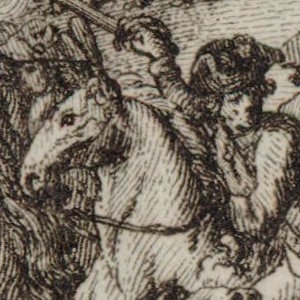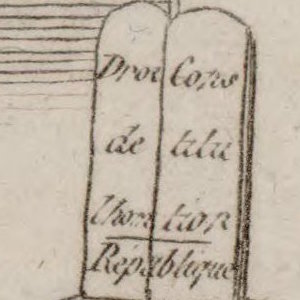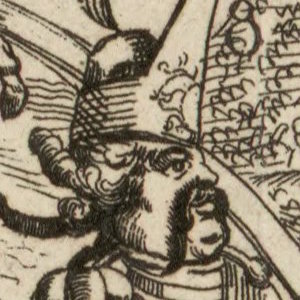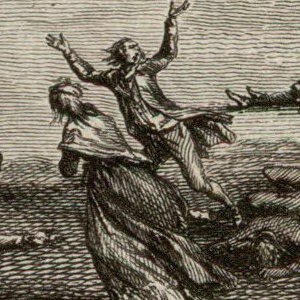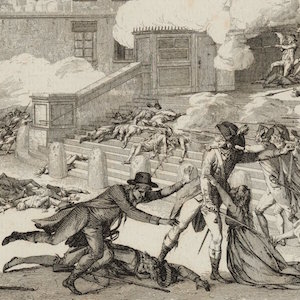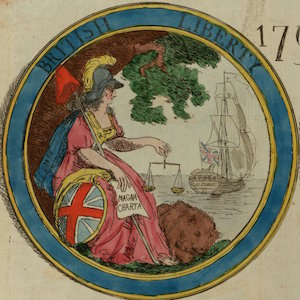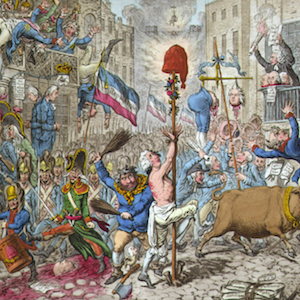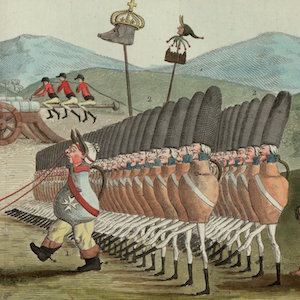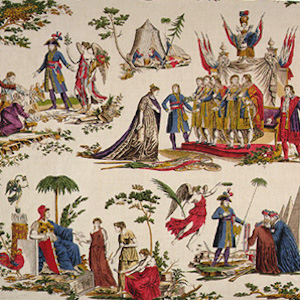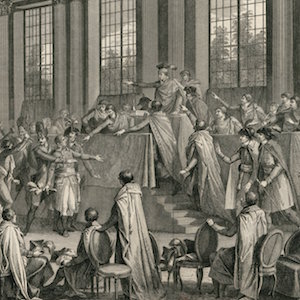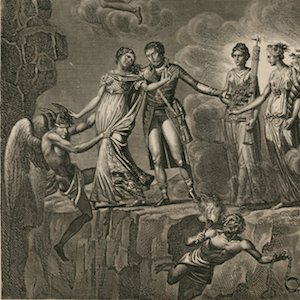Source Collection: War, Terror, and Resistance to the French Revolution
Overview
One fault line that has divided inquiries into the Terror has been its connections to the democracy introduced in 1789. For some, the Terror had to occur, either to sweep away the remnants of the Old Regime or, from a more critical perspective, because the revolutionaries had inadvertently introduced authoritarianism with their seeming democratic principles. Others have seen the French revolution simply swept off course, the Terror as result of unforeseen circumstances. But regardless of which position one occupies, one must look to the frantic policies of the period: its ongoing foreign and civil war, multilayered internal political strife, constitutional paralysis, economic hardships, religious conflict, and the innovative nature of revolutionary language. For those who see the Terror as unconnected to 1789, these events are the very things that cause the problems. For the others, these events manifest the solution of 1789. This chapter, then, focuses on this political tornado as an essential part of any explanation.
This source collection includes an informational essay and 75 primary sources.
Essay
Back in 1789, the National Assembly had declared its intentions toward all peoples to be peaceful and had renounced war as an evil wrought by kings. Nevertheless, bellicose sentiments flowed into governmental debates and the press. Eighteenth-century governments looked upon war as a normal part of power politics, so foreign governments did not hesitate to threaten war with the new, revolutionary government of France. Yet foreign monarchs, while fearing the spread of revolution, were not unhappy with the turmoil afflicting their French rival. Beset by their own problems, the monarchs of Europe were less inclined than some revolutionaries feared to make good on their threats.
Creating further anxiety among the revolutionaries were a group of French nobles who had fled France and set up a capital in exile just over the Rhine River in ecclesiastical territory at Coblenz. In this fearful atmosphere, revolutionary activists, notably Jacques-Pierre Brissot and the other Girondins, found that militaristic rhetoric drew ready popular support, and this group's promises of aggressive confrontation with foreign powers helped them dominate the Legislative Assembly. Once in control, the Girondins rapidly led France into war in the spring of 1792, but this strategy backfired when French forces performed badly for most of that year and as a consequence France was invaded by Prussian and Austrian troops.
These defeats panicked Parisians, contributing to the radicalization that culminated in the overthrow of the constitutional monarchy in August 1792. News of the first great French victory at Valmy on 20 September allowed the newly seated deputies of the Convention to declare France a republic. The Girondins used the ongoing war to generate a great outpouring of support for the new republic. However, subsequent military setbacks in late 1792 and 1793 served to heighten factionalism in the Convention, where the radical group of Jacobin deputies known as "the Mountain" and the Girondins blamed each other, each claiming that only they could be trusted to save the now-endangered republic.
In Paris, news of this civil war hardened sans-culotte suspicions that the fervor of the defenders of republican liberty had subsided, so they turned for help to radical activists who were willing to mobilize to preserve it.
Beginning in 1792, the Mountain had begun to ally with sans-culottes in the sectional assemblies, and together they overthrew the monarchy and the Girondin-led Legislative Assembly. Sans-culotte fears of the plots of invisible, domestic enemies of the Revolution were further aroused by heated rhetoric during the trial of Louis in January 1793, at which the Mountain depicted the Girondins as moderate defenders of the monarchy and thus de facto protectors of "tyranny." The alliance between artisanal activists in the sections and the Mountain's deputies in the Convention was forged around the idea of mutual commitment to dramatic action in defense of the Republic from its enemies, including the Girondin deputies who had been purged by 2 June 1793. The Mountain then assumed control of the National Convention.
This process coincided with the outbreak of another form of civil war, inextricably tied to revolutionary politics, in the western region of the Vendée, where peasants, former nobles, and refractory priests coalesced into a guerrilla army that waged a war against the republican government. To explain why this region in particular resisted the authority of Paris—to the point of openly seeking alliance with Britain to restore the monarchy—one must consider the specific conditions that distinguished the west from the rest of France. It was geographically isolated, more rural, and culturally and religiously distinct (with its own language and many regional saints and holidays) and had a heavier density of nobles and clergy. These factors crystallized in the spring of 1793, when Paris called for 300,000 "volunteers" for the republican army. In response, peasants in the Vendée rejected the Republic's levy, and local ex-nobles drew on this protest to mobilize a ragtag army and seize control of the region. Not surprisingly, such regional resistance furthered the belief among Parisian radical republicans that the Revolution's greatest enemies were French "counterrevolutionaries," who fomented rebellion out of self-interest or an inability to set aside traditional beliefs and adapt to the new order. To defeat this rebellion, the Revolution would have to destroy not only its enemies, but also the reasons for such treachery.
Origins of the Terror
The monumental task of governing a country in the midst of revolutionary transformation is a difficult one at best. But with a faction-riven 600-member legislature, it proved nearly impossible. Recognizing that fact, the Convention, even before the victory of the Mountain, had delegated power to a twelve-member Committee of Public Safety (CPS) created in the spring of 1793. A "Montagnard" Constitution, drafted that summer, set out a plan for democracy and economic equality that was more far-reaching than any earlier project. However, faced with war, internal unrest, and other problems, the Mountain argued that the government must become "revolutionary" (meaning extraconstitutional) if it was to run effectively and also systematically and swiftly confront its hidden, internal enemies. In early September, pushed by the sans-culottes, the Committee of Public Safety led the Convention into what became known as "The Terror."
The Terror as a form of government meant the organized use of state coercive power to ensure compliance with the demands of the government. Those who did not comply faced a revolutionary tribunal, which tried "suspects" for treason and sentenced those it convicted to the guillotine. These suspects included foreign and domestic enemies. The Terror was also used to enforce wage and price "maximums" that guaranteed affordable provisions as well as more nebulous aims, such as ensuring the "virtue" of all citizens, which allowed the CPS to repress all dissent from its own decrees.
From September 1793 through July 1794, the "revolutionary government" of the Terror overwhelmed its enemies and permeated nearly all aspects of life. Yet its very success was a major part of its undoing. By the end of 1793, even some of the most radical Jacobins, notably Georges Danton, began to argue that the violence had gone too far and had become a source of instability in the Republic. His ally, Camille Desmoulins, published Le Vieux Cordelier [The Old Cordelier], an occasional newspaper that criticized the authoritarian tendencies of the Committee of Public Safety. Others censured the CPS for its centralizing tendencies, which dampened popular participation and were not in accord with the Revolution's announced goal of achieving greater democracy.
The Implementation of the Terror
The chief target of the Terror was the counterrevolution, which referred to a series of distinct movements that sought to resist the revolutionary government's authority within France. In the west, republican forces confronted peasant armies in the Vendée (discussed above) and later another group of peasant insurgents known as the Chouans. In the center and south, government troops laid siege to cities that disputed the Mountain's hypercentralized vision of revolutionary government and distrusted the sans-culottes. These urban revolts, although they varied somewhat from city to city, appeared to Parisians as a single movement, which they labeled "federalism." Its proponents—in cities such as Nantes, Toulouse, Lyons, Bordeaux and Marseilles—acted independently and represented themselves as moderate revolutionaries, but leaders in Paris saw them as nothing less than royalists who had to be eliminated. In the most dramatic cases, the Convention sent its deputies as "representatives on mission" to oversee the liquidation of federalist strongholds. The use of the prestige and energy of legislative deputies to enforce the law, mobilize the nation's resources for war, and quell armed rebellion was a marked feature of the Terror. This tactic allowed the arm of the central government to reach into many nooks and crannies that might have escaped the long arm of revolutionary justice. The representatives on mission usually were sent out with "unlimited powers" to allow them to accomplish the monumental tasks they faced. Such authority was often abused, and the representatives frequently emerged as the most zealous proponents and executors (literally) of the Terror. For example, on the orders of two leading Montagnard deputies, Lyons was bombarded heavily by government troops. When Lyons fell, it was renamed "the freed city." At Nantes, another representative on mission ordered that thousands of rebels be drowned on barges sunk in the Loire River.
The Convention fought the counterrevolution on another front in October 1793 by trying and executing Marie Antoinette, since they believed her a figure around whom monarchists and foreign powers could rally. The fall and winter of 1793 also saw the revolutionary government pursue its foes abroad, as the armies of the Republic, under new leadership, held the line against the invading Prussians, Austrians, Savoyards, Spaniards, and English. By early 1794, the French armies created through the much-reviled draft had succeeded in defeating the invaders and were beginning to occupy territory particularly along the northern and eastern frontiers.
The Rise and Fall of the Factions
With every victory, however, the Committee of Public Safety found itself engaged in another battle for survival in domestic politics. The CPS fought off repeated attacks by both radicals and moderates in the press and in sectional assemblies, but for different reasons. The radicals called themselves "The Enraged" and accused the government of leniency. They demanded a more restrictive price maximum, especially on basic necessities, while self-described "Indulgents" questioned the committee's extremism, fearing that the constant repression of citizens' hard-won liberties in the name of "virtue" would undermine popular support for the Revolution.
Another major divisive force in contemporary politics was the Convention's wide-ranging attempt not merely to restrain the citizenry but to transform it into a more rational and secular society. In a far-reaching break with tradition and with Christianity, the revolutionaries inaugurated a new calendar of twelve months, each divided into three ten-day weeks. This calendar eliminated Sunday, the traditional day of markets, of socializing, and of Church attendance in favor of a republican holiday every ten days. Showing some restraint in its desire to remake time and space, the Convention rejected a proposed revolutionary clock that would have divided each day into 20 hours of 100 minutes each, but commissioned a study that created the metric system for redefining weights and measures.
Furthermore, the revolutionaries imagined education as the keystone of the French nation and planned to institute universal primary education. They also wanted to improve secondary and higher education as a means of demonstrating the glory of the French nation and the "enlightenment" of its citizens. These goals were to apply not only to the heartland of France, but also to conquered Italian-, German-, and Flemish- speaking territories. However, most all these grandiose plans were shelved because the war made the more propagandistic ingredients of the revolutionary civic education the only feasible options.
Perhaps the Revolution's most radical and divisive initiative was the move to "de-Christianize" France and institute a civil religion based entirely on "reason." Inspired by Enlightenment criticisms of the Catholic Church and in many ways embodying the Revolution's desire to transform French society at the most fundamental level, the Cult of Reason proved highly controversial in practice. Robespierre himself thought the seemingly atheistic Cult of Reason excessive and counter to the objective of establishing a republic of virtue. Seeking to preserve a religion based on the notion of a higher power that would replace Christianity, Robespierre organized the Festival of the Supreme Being held in June 1794, casting himself in the title role.
In retrospect, this attempt to arrive at a compromise between deism and atheism seems to have precipitated Robespierre's fall and the end of the Terror. Robespierre's proposed synthesis of Enlightenment views on religion and republican values troubled some, who thought that "The Incorruptible" had now lost all self-restraint and was paving the way for a dictatorship. Others feared that he was abandoning the dechristianization campaign and that their activities would now expose them to the Terror. These fears mounted when two days later Robespierre pushed through the Law of 22 Prairial (10 June 1794), which put the apparatus of the Terror directly under the control of the Committee of Public Safety and thus increased the possibility of explicit political prosecutions and executions. Robespierre justified the new law as a necessary instrument to instill virtue in the citizenry, but these remarks merely persuaded people that he sought to eliminate his opponents and establish a personal dictatorship. By the end of July, Robespierre's enemies had begun circulating false rumors in Paris suggesting that he intended to make himself king. Even his base of support at the Jacobin Club was eroding because he continued to rely on Terror to achieve his political goals. Those who feared another purge helped his detractors pass a resolution in the Convention condemning him and his followers, which led to their arrest and execution. The leaders of the coup against Robespierre acted to save themselves from the Terror, not to end the Terror as such or to dissolve the Committee of Public Safety. It would take several months before this fear of further purges would bring the authorities to repeal the law of 22 Prairial, emasculate the CPS, eliminate the revolutionary tribunals, and abandon the maximums. By the late fall, however, this transition would be complete and a new era of the Revolution would have begun.
The War from 9 Thermidor to 18 Brumaire
Although the revolutionary armies had already turned the tide of battle in the spring of 1794, the resources gained through terroristic methods after 9 Thermidor permitted them to conquer extensive territory. By the fall of 1795, the first coalition of Britain, Austria, Prussia, Spain, Netherlands, and Savoy had been defeated, and France held modern-day Belgium and the west bank of the Rhine River. Once the Netherlands, Spain, Savoy, and Prussia made peace, France could continue on the offensive. In 1796–97, an outnumbered and ragtag army of about 30,000 effective soldiers under the command of Napoleon Bonaparte defeated a much larger Austrian force to conquer the Italian peninsula. There Bonaparte set up a group of "sister republics," which extended French influence without officially extending French territory.
Having defeated Austria and recognizing that an invasion of Great Britain was impossible, the leaders of the French government encouraged the very popular Bonaparte to look for other means of striking at England, in part, just to get him out of the way. When he suggested invading Egypt as a means of threatening the English position in India, Bonaparte was given permission to push ahead with the idea. In 1798, Napoleon led a sizable army and much of the French fleet across the Mediterranean. Although Egypt swiftly fell to French arms, Bonaparte's army was stranded there by Admiral Horatio Nelson's decisive naval victory at Aboukir Bay. Rather than remain sequestered in Egypt, Bonaparte abandoned his army to return to France, where his heroic reputation and military prowess was bolstered by slick propaganda and a considerable amount of war booty.
Bringing the Revolution to a Close?
After five years of upheaval, the Revolution had left France divided, angry, and distrusting but in need of central authority. In the fall of 1794, the Convention, no longer controlled by the Committee of Public Safety and with the surviving Girondin deputies restored to it, resumed its efforts to draft a constitution. The Convention recognized that the rule of law had to be restored if the authority of the government was to recover from the effects of the Terror. With the Girondin deputies reinstated, however, there was no question of implementing the "Montagnard" Constitution of 1793. Instead, a new constitution—that of the Year III (1795)—was written. This document clearly intended to preserve the political power of the socioeconomic elite, through the reimposition of property restrictions for officeholding and the suffrage. Social equality was notably absent because Jacobin ideas on democracy were tarnished with the reputation of being inherently dangerous to the rule of law and likely to result in Terror. The new government invested the lion's share of power in an executive body, the Directory, composed of a rotating committee of five "Directors," who would preside over a bicameral legislature, an upper chamber named the Anciens (Elders)—all of whose members had to be at least forty years old, to ensure their maturity of judgment—and a lower house known as "the Five Hundred."
The Convention's distrust of the polity was revealed most clearly in a decree requiring two-thirds of the deputies to the next legislature to be members of the Convention. Recognizing that this measure would leave radicals in charge of the government, some royalist-influenced sections revolted in Vendémiaire, Year IV (October 1795). The army put down the rising under the command of Napoleon Bonaparte. (This loyal action won him his command in Italy.) Thus the directorial regime came to power with military support and would remain dependent on that support to survive.
During its four years in power (November 1795 to December 1799), the Directory consistently faced challenges to its legitimacy, not only from the heirs of the Jacobins on the Left, but also from returning émigré nobles demanding restitution of their property; conservative street gangs known as the "gilded youth," who were anxious to harass former terrorists; and a revived armed mobilization in the west of Chouans acting in coordination with the English and with other émigré nobles led by the Count of Provence, who now claimed the throne as Louis XVIII.
Yet the most significant threat to the Directory's stability lay within the framework of the new constitution, as the elections of 1797—the first in which no former Convention deputies would be incumbent for reelection—returned a royalist majority divided between those who favored a constitutional monarchy and those who demanded a restoration of the old regime. The Directors attempted to steer a middle course, believing that their primary responsibility was to preserve a moderate republic, which meant keeping both royalists and Jacobins out of power. Preferring stability to democracy, the Directors annulled the electoral results from the Year V in a coup on 18 Fructidor (September 1797). This same strategy would be used in the Year VI (1798) against the Jacobin movement, which had been permitted to reform political clubs known as Constitutional Circles. A coup of Floréal Year VI (May 1798) showed that the pendulum of political opinion was behaving erratically and could readily shift from radical Left to Right, and vice versa.
The Road to Brumaire
By this time, international opinion had also become disenchanted with the Revolution. The experience of the Terror had altered definitively outsiders' views of France, driving it from sympathy in 1789 to hostility and derision by 1795. Certainly the Terror and the defeat of the pro-French "patriot" movement in England itself emboldened British cartoonists to lambaste the French revolutionaries, particularly their claims of having achieved "liberty" unknown elsewhere in Europe.
If the executive council of the Directory remained impervious to both the military and caricatural insults of the British, it faced far more onerous challenges in the arena of domestic politics. The Directory's continual reliance on military force against its own citizens revealed its instability. Sieyès, as a delegate of the Third Estate in 1789, had been instrumental in initiating the Revolution, but now as a Director in 1799, he would take the lead in ending it because he believed that anarchy would reign unless the government was reorganized. Turning to the most popular figure on the political landscape—General Bonaparte, freshly returned from Egypt—Sieyès arranged for a coup that would consolidate all power in a three-man consulate to include himself, Bonaparte, and Roger Ducos. With Bonaparte's brother Lucien manipulating the Council of Five-Hundred into consent, the coup of 18 Brumaire (9 November 1799) replaced the Directory with the Consulate, a government neither liberal nor democratic. Bonaparte, whose political skills Sieyès drastically underestimated, immediately seized the upper hand and emerged within a couple of months as the real leader of France, taking first the title of First Consul (1799–1802), then Consul for Life (1802–4), and finally crowning himself Emperor (1804–14, 1815).
Although the Directory is best known for its activities in war and politics, it was also very busy in other fields. In a number of ways, it pursued the Revolution's goal of rationalizing everything, from the system of weights and measures to the lay system of free, compulsory, secondary education. Outside its official activities, the Directory achieved notoriety for ushering in a period of excess: the wealthy and fashionable flaunted their riches through ostentatious displays of self-indulgence as a reaction to the Jacobin prudery and sans-culotte economic leveling. In the most spectacular case, the wife of one of France's leading politicians, Madame Tallien, went topless, drawing considerable comment and criticism.
The multiple directions in which the Directory seemed to move—expanding secondary education while restricting political rights, gaining territory on the battlefield while becoming ridiculed by educated Europeans, assuring the citizens it would defend "republican institutions" while allowing power to be consolidated ever more narrowly—all make this "unheroic" period of the French Revolution difficult to assess. Even scholars have given it relatively little attention. Yet it deserves careful consideration because it consolidated the achievements of the first half of the revolutionary decade and because similar contradictions continue to plague nations to this very day.
Primary Sources
Credits
From LIBERTY, EQUALITY, FRATERNITY: EXPLORING THE FRENCH REVOLUTION, https://revolution.chnm.org/exhibits/show/liberty--equality--fraternity/war-terror-and-resistance



